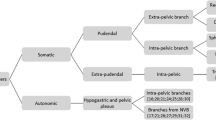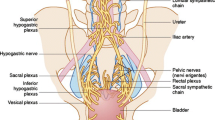Abstract
Introduction
In the pelvis, the rectogenital septum (RGS) separates the urogenital compartment from the digestive compartment. In men, it corresponds to Denonvilliers’ rectoprostatic fascia or rectovesical septum (RVS). Its purpose—and, indeed, its existence—are controversial in women. The purpose of this review was to update knowledge about the RGS in women and, in particular, to clarify its relationship to pelvic nerves in order to deduce practical consequences of pelvic surgery and compare it to the RVS in men.
Methods
A review of the anatomical and surgical literature was undertaken. Evidence for embryological origin, composition, and surgical importance of the RGS in women and men is suggested.
Results
This manuscript presents evidence of the existence of the RGS in both women (rectovaginal septum, RVaS) and men (rectovesical septum, RVS). It originates from the genital structures and extends from the rectogenital pouch to the perineal body. It is composed of connective tissue associated with bundles of smooth muscle cells and has lateral expansions in close contact with neurovascular bundles originating from the inferior hypogastric plexus. During pelvic surgery for carcinoma, preservation of nerve fibers of erectile bodies is necessary if possible. The RGS is thus an important surgical landmark during urogenital sinus surgery, prolapse surgery, and proctectomy in women as well as during proctectomy and prostatectomy in men.
Conclusions
The RGS is present in women as well as in men, with great similarities between the two sexes. It represents an important surgical landmark during pelvic nerve-sparing surgery.





Similar content being viewed by others
Abbreviations
- CN:
-
Cavernous nerve
- IHP:
-
Inferior hypogastric plexus
- DSDs:
-
Disorders of sex development
- NVB:
-
Neurovascular bundle
- PPF:
-
Pelvic parietal fascia
- PSF:
-
Presacral fascia
- RGS:
-
Rectogenital septum
- RVF:
-
Rectal visceral fascia (fascia recti)
- RVP:
-
Rectovaginal pouch (rectouterine pouch)
- RVS:
-
Rectovesical septum (rectoprostatic fascia of Denonvilliers)
- RVaS:
-
Rectovaginal septum
- SN:
-
Spongious nerve
References
Denonvilliers C-PD (1836) Anatomy of the perineum. Bull Soc Anat Paris 11:105–107
Heald RJ, Moran BJ, Brown G, Daniels IR (2004) Optimal total mesorectal excision for rectal cancer is by dissection in front of Denonvilliers’ fascia. Br J Surg 91:121–123
Maas CP, Kenter GG, Trimbos JB, Deruiter MC (2005) Anatomical basis for nerve-sparing radical hysterectomy: immunohistochemical study of the pelvic autonomic nerves. Acta Obstet Gynecol Scand 84:868–874
Walsh PC, Lepor H, Eggleston JC (1983) Radical prostatectomy with preservation of sexual function: anatomical and pathological considerations. Prostate 4:473–485
Benoit G, Delmas V, Gillot C, Hureau J (1984) Anatomical basis of total prostatocystectomy in man. Anat Clin 5:213–219
Clausen N, Wolloscheck T, Konerding MA (2008) How to optimize autonomic nerve preservation in total mesorectal excision: clinical topography and morphology of pelvic nerves and fasciae. World J Surg 32:1768–1775
Peschaud F, Moszkowicz D, Alsaid B, Bessede T, Penna C, Benoit G (2012) Preservation of genital innervation in women during total mesorectal excision: which anterior plane? World J Surg 36:201–207
Kleeman SD, Westermann C, Karram MM (2005) Rectoceles and the anatomy of the posteriorvaginal wall: revisited. Am J Obstet Gynecol 193:2050–2055
Richardson AC (1993) The rectovaginal septum revisited: its relationship to rectocele and its importance in rectocele repair. Clin Obstet Gynecol 36:976–983
Uhlenhuth E, Nolley GW (1957) Vaginal fascia, a myth. Obstet Gynecol 10:349–358
Aigner F, Zbar AP, Ludwikowski B, Kreczy A, Kovacs P, Fritsch H (2004) The rectogenital septum: morphology, function, and clinical relevance. Dis Colon Rectum 47:131–140
Bertrand MM, Alsaid B, Droupy S, Benoit G, Prudhomme M (2014) Biomechanical origin of the Denonvilliers’ fascia. Surg Radiol Anat SRA 36:71–78
Milley PS, Nichols DH (1969) A correlative investigation of the human rectovaginal septum. Anat Rec 163:443–451
Kim JH, Kinugasa Y, Hwang SE, Murakami G, Rodríguez-Vázquez JF, Cho BH (2015) Denonvilliers’ fascia revisited. Surg Radiol Anat SRA 37:187–197
CunéoB VV (1989) Morphological signification of perivesical aponeurosis. J Anat Physiol 35:235–245
Huebner M, Rall K, Brucker SY, Reisenauer C, Siegmann-Luz KC, DeLancey JOL (2014) The rectovaginal septum: visible on magnetic resonance images of women with Mayer-Rokitansky-Küster-Hauser syndrome (Müllerian agenesis). Int Urogynecol J 25:323–327
Kraima AC, West NP, Treanor D, Magee DR, Rutten HJ, Quirke P, DeRuiter MC, van de Velde CJ (2015) Whole mount microscopic sections reveal that Denonvilliers’ fascia is one entity and adherent to the mesorectal fascia; implications for the anterior plane in total mesorectal excision? Eur J Surg Oncol J Eur Soc Surg Oncol Br Assoc Surg Oncol 41:738–745
Moszkowicz D, Alsaid B, Bessede T, Penna C, Benoit G, Peschaud F (2011) Female pelvic autonomic neuroanatomy based on conventional macroscopic and computer-assisted anatomic dissections. Surg Radiol Anat SRA 33:397–404
Moszkowicz D, Alsaid B, Bessede T, Penna C, Nordlinger B, Benoît G, Peschaud F (2011) Where does pelvic nerve injury occur during rectal surgery for cancer? Colorectal Dis Off J Assoc Coloproctol G B Irel 13:1326–1334
Moszkowicz D, Alsaid B, Bessede T, Zaitouna M, Penna C, Benoit G, Peschaud F (2011) Neural supply to the clitoris: immunohistochemical study with three-dimensional reconstruction of cavernous nerve, spongious nerve, and dorsal clitoris nerve in human fetus. J Sex Med 8:1112–1122
Ludwikowski B, Hayward IO, Fritsch H (2002) Rectovaginal fascia: An important structure in pelvic visceral surgery? About its development, structure, and function. J Pediatr Surg 37:634–638
Zhai L-D, Liu J, Li Y-S, Yuan W, He L (2009) Denonvilliers’ fascia in women and its relationship with the fascia propria of the rectum examined by successive slices of celloidin-embedded pelvic viscera. Dis Colon Rectum 52:1564–1571
Leffler KS, Thompson JR, Cundiff GW, Buller JL, Burrows LJ, Schön Ybarra MA (2001) Attachment of the rectovaginal septum to the pelvic sidewall. Am J Obstet Gynecol 185:41–43
Nichols DH, Milley PS (1970) Surgical significance of the rectovaginal septum. Am J Obstet Gynecol 108:215–220
Kinugasa Y, Murakami G, Uchimoto K, Takenaka A, Yajima T, Sugihara K (2006) Operating behind Denonvilliers’ fascia for reliable preservation of urogenital autonomic nerves in total mesorectal excision: a histologic study using cadaveric specimens, including a surgical experiment using fresh cadaveric models. Dis Colon Rectum 49:1024–1032
Tobin CE, Benjamin JA (1945) Anatomical and surgical restudy of Denonvilliers’ fascia. Surg Gynecol Obstet 80:373–388
Nagata I, Murakami G, Suzuki D, Furuya K, Koyama M, Ohtsuka A (2007) Histological features of the rectovaginal septum in elderly women and a proposal for posterior vaginal defect repair. Int Urogynecol J Pelvic Floor Dysfunct 18:863–868
Bisset IP, Chau KY, Hill GL (2000) Extrafascial excision of the rectum: surgical anatomy of the fascia propria. Dis Colon Rectum 43:903–910
Villers A, McNeal JE, Freiha FS, Boccon-Gibod L, Stamey TA (1993) Invasion of Denonvilliers’ fascia in radical prostatectomy specimens. J Urol 149:793–798
Mauroy B, Demondion X, Bizet B, Claret A, Mestdagh P, Hurt C (2007) The female inferior hypogastric (= pelvic) plexus: anatomical and radiological description of the plexus and its afferences--applications to pelvic surgery. Surg Radiol Anat SRA 29:55–66
Mauroy B, Bizet B, Bonnal JL, Crombet T, Duburcq T, Hurt C (2007) Systematization of the vesical and uterovaginal efferences of the female inferior hypogastric plexus (pelvic): applications to pelvic surgery on women patients. Surg Radiol Anat SRA 29:209–217
Smith GE (1908) Studies in the Anatomy of the Pelvis, with Special Reference to the Fasciae and Visceral Supports: Part II. J Anat Physiol 42:252–270
Van Ophoven A, Roth S (1997) The anatomy and embryological origins of the fascia of Denonvilliers: a medico-historical debate. J Urol 157:3–9
Silver PH (1956) The role of the peritoneum in the formation of the septum recto-vesicale. J Anat 90:538–546
Wesson MB (1922) An anatomical and embryological study of the perineum. Calif State J Med 20:269–272
Secin FP, Karanikolas N, Gopalan A, Bianco FJ, Shayegan B, Touijer K, Olgac S, Myers RP, Dalbagni G, Guillonneau B (2007) The anterior layer of Denonvilliers’ fascia: a common misconception in the laparoscopic prostatectomy literature. J Urol 177:521–525
Bertrand MM, Alsaid B, Droupy S, Benoit G, Prudhomme M (2013) Optimal plane for nerve sparing total mesorectal excision, immunohistological study and 3D reconstruction: an embryological study. Colorectal Dis Off J Assoc Coloproctol G B Irel 15:1521–1528
Kourambas J, Angus DG, Hosking P, Chou ST (1998) A histological study of Denonvilliers’ fascia and its relationship to the neurovascular bundle. Br J Urol 82:408–410
Kiyoshima K, Yokomizo A, Yoshida T, Tomita K, Yonemasu H, Nakamura M, Oda Y, Naito S, Hasegawa Y (2004) Anatomical features of periprostatic tissue and its surroundings: a histological analysis of 79 radical retropubic prostatectomy specimens. Jpn J Clin Oncol 34:463–468
Lindsey I, Mortensen NJM (2002) Iatrogenic impotence and rectal dissection. Br J Surg 89:1493–1494
Dumonceau O, Delmas V, Toublanc M, Lassau JP, Boccon-Gibod L (2002) Innervation of Denonvilliers’ recto-vesical septum. Anatomic study. Morphol Bull Assoc Anat 86:17–20
Alsaid B, Bessede T, Karam I, Abd-Alsamad I, Uhl J-F, Benoît G, Droupy S, Delmas V (2009) Coexistence of adrenergic and cholinergic nerves in the inferior hypogastric plexus: anatomical and immunohistochemical study with 3D reconstruction in human male fetus. J Anat 214:645–654
Alsaid B, Bessede T, Diallo D, Moszkowicz D, Karam I, Benoit G, Droupy S (2011) Division of autonomic nerves within the neurovascular bundles distally into corpora cavernosa and corpus spongiosum components: immunohistochemical confirmation with three-dimensional reconstruction. Eur Urol 59:902–209
Cornu J-N, Phé V, Fournier G, Delmas V, Sèbe P (2010) Fascia surrounding the prostate: clinical and anatomical basis of the nerve-sparing radical prostatectomy. Surg Radiol Anat SRA 32:663–667
Maher C, Baessler K (2006) Surgical management of posterior vaginal wall prolapse: an evidence-based literature review. Int Urogynecol J Pelvic Floor Dysfunct 17:84–88
Da Silva GM, Hull T, Roberts PL, Ruiz DE, Wexner SD, Weiss EG, Nogueras JJ, Daniel N, Bast J, Hammel J, Sand D (2008) The effect of colorectal surgery in female sexual function, body image, self-esteem and general health: a prospective study. Ann Surg 248:266–272
Lindsey I, Warren B, Mortensen N (2004) Optimal total mesorectal excision for rectal cancer is by dissection in front of Denonvilliers’ fascia (Br J Surg 2004; 91: 121–123). Br J Surg 91:897
Lindsey I, Warren BF, Mortensen NJ (2005) Denonvilliers’ fascia lies anterior to the fascia propria and rectal dissection plane in total mesorectal excision. Dis Colon Rectum 48:37–42
Moszkowicz D, Peschaud F (2014) Step-by-step nerve-preserving mesorectal excision in the female. J Visc Surg 151:137–140
Villers A, McNeal JE, Redwine EA, Freiha FS, Stamey TA (1989) The role of perineural space invasion in the local spread of prostatic adenocarcinoma. J Urol 142:763–768
Patel VR, Coelho RF, Palmer KJ, Rocco B (2009) Periurethral suspension stitch during robot-assisted laparoscopic radical prostatectomy: description of the technique and continence outcomes. Eur Urol 56:472–478
Acknowledgments
The authors thank Dr. Mostaffa El Hajjam (Service de Radiologie, Hôpital Ambroise Paré, Boulogne-Billancourt, France) for imaging pictures, Pr. Bruno Deval (Chirurgie gynécologique, Clinique Geoffroy Saint-Hilaire, Paris, France) and Pr. Georges Audry (Service de Chirurgie Viscérale pédiatrique et néonatale, Hôpital Trousseau, Paris, France) for surgical pictures.
Author information
Authors and Affiliations
Corresponding author
Ethics declarations
Conflict of interest
The authors declare that they have no conflict of interest.
Rights and permissions
About this article
Cite this article
Dariane, C., Moszkowicz, D. & Peschaud, F. Concepts of the rectovaginal septum: implications for function and surgery. Int Urogynecol J 27, 839–848 (2016). https://doi.org/10.1007/s00192-015-2878-3
Received:
Accepted:
Published:
Issue Date:
DOI: https://doi.org/10.1007/s00192-015-2878-3




